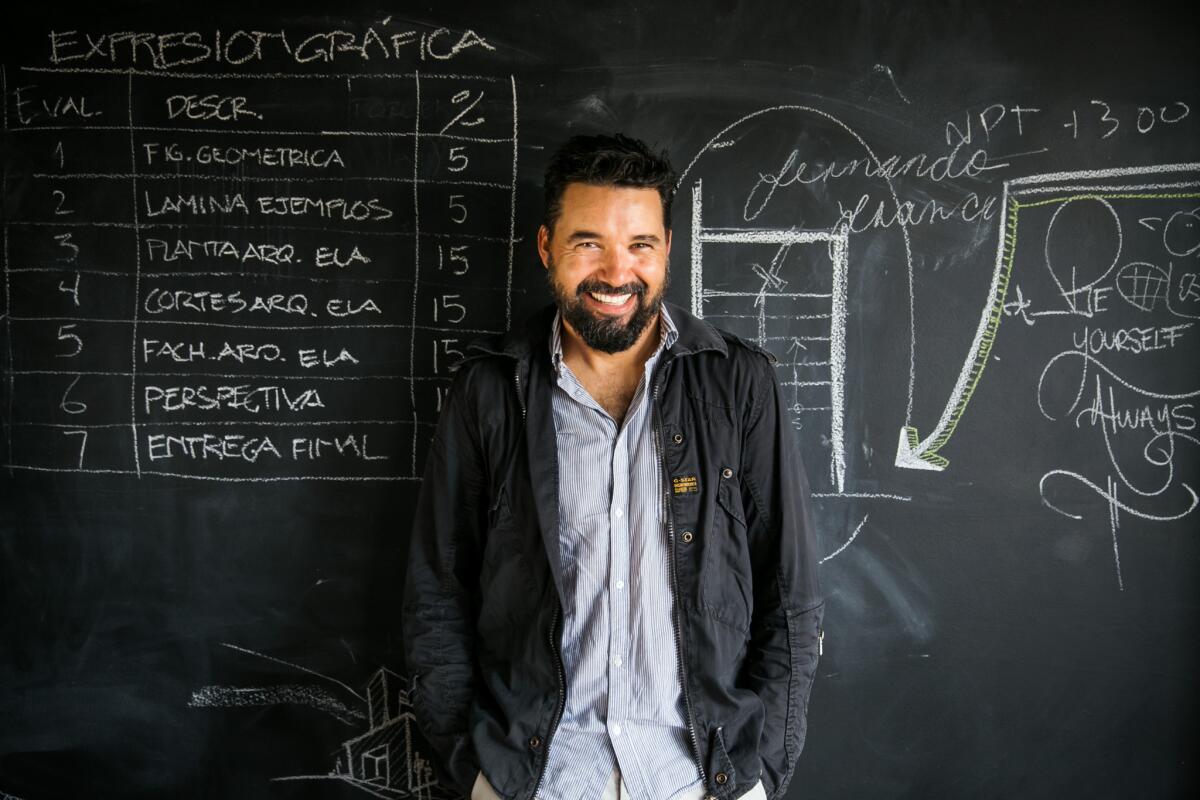An architecture school rises in Tijuana’s red light zone

- Share via
La Coahuila is not the sort of neighborhood anyone would mistake for an architecture and design district. But here in Tijuana's red light zone, a place better known for its tumble-down bars, by-the-hour hotels and risque floor shows than anything to do with Modernism, a new architecture school is turning the design field on its head.
Within view of the U.S.-Mexico border, inside a bland, three-story office building that once housed a medical clinic for sex workers, the Escuela Libre de Arquitectura (Architecture Free School) was founded by Tijuana architect Jorge Gracia with its surroundings very much in mind.
"I didn't want to be off in the suburbs somewhere, off in some neighborhood full of towers," Gracia says. "I wanted to be right in the middle of things."
Indeed, from his sunny corner office, it is possible to take in not only panoramic views of the monumental steel arch that greets visitors to the city but a working girl in hot pants on the street below, cellphone tucked protectively in her cleavage.
It is the Tijuana context that shapes everything about this unorthodox school, which opened in fall 2014. Tijuana is a singular juncture of the handmade and the high-tech, a city that boasts one of Mexico's most developed manufacturing centers, in a country where roughly half the population lives under the poverty line. Far from the Mexican centers of power, it is a place that pragmatically makes do with the never-ending flow of ideas and material that wash in from the U.S.
This pragmatism reaches down to the architecture school's curriculum, bringing a highly practical approach to education in a field that is often more focused on pie-in-the-sky theory than the nuts and bolts of getting things built. As in other schools, the Escuela Libre de Arquitectura has sessions devoted to experimental design and Classical proportion, but there are also regular visits to construction sites to understand the mechanics of poured-in-place concrete.
"Many architecture students can conceptualize incredible designs, but they cannot build them," Gracia says. "We want students to be able to build — to go to a building or a plaza and be able to analyze what works and what doesn't. And we want them to work within the social context, in this case, of Tijuana."
"Tijuana is our laboratory," says Enrique González Silva, the school's founding academic director. "The idea of the program is that the students understand the reality of being an architect here."
It's a mission the school takes deeply to heart.
On a steamy weekday morning, Gracia and González Silva pack a class of 15 students into a van and drive them to a construction site at a rising residential development southeast of downtown, where Gracia's architectural firm, Gracia Studio, is building a home for a client. Though at the moment it is less a home and more an array of steel cages and half-poured concrete walls.
Gracia distributes construction helmets to the class and guides them into the site, picking his way around piles of reinforced steel bars (rebar) and the myriad gaps in the unfinished floor (of the sort that would give a U.S. liability lawyer conniptions).
"Right here, these are the molds for the concrete," Gracia tells the students as they take notes and snap pictures. "And right here, this rebar — depending on the thickness, it has different weight-bearing capacities."
The class then gathers with the construction workers shaping the rebar to understand how that process works. A number of them even join in, donning work gloves to help bend the steel bars that will ultimately support the home's second story.
"We require that they really understand the materials they work with," González Silva says. "We are very focused on the practical — learning what a working architect does, learning how to design efficiently, how to build cost-effectively, how to work with builders."
For the students, it is a world away from a traditional architectural education, which, in the early years, is generally focused on history and conceptual projects that never go beyond the classroom.
"A lot of our classes take place in places like carpentry workshops," says second-year student Fabio Campanaro, who hails from San Diego — the school's lone U.S. student. "Or if we are having a class on concrete, we have the class at a place where they manufacture concrete. So you get a lot of real-world experience."
Campanaro, 28, had begun his architecture studies at the New School of Architecture & Design in San Diego but stopped going because of financial problems. He heard about the launch of the Escuela Libre at a lecture he attended in Tijuana, and when he was ready to go back to school, he decided he would go to Tijuana to study.
"In the States, it's much more of an academic environment," he explains. "Maybe you do one or two field trips, but at the Escuela Libre, it's almost weekly. One day you come when they're pouring the foundation, one day when they're pouring the walls. You get a real understanding of the building process."
The school, of course, doesn't ignore theory. "I'd say it's 40% theory and 60% practice," Gracia says of the school's courses. "The theory is very important. But we want students to be able to design and build."
Like a lot of Tijuana's institutions, which are built from the ground up by enterprising individuals, Gracia launched the Escuela Libre de Arquitectura because he saw a need.
The 41-year-old Tijuana native has operated a well-regarded architectural firm in the city for more than a decade. His award-winning work — which includes hotels, a culinary school and several private homes — has been featured in Dwell, Architectural Record and other publications. But over the years, as he has come into contact with a generation of young designers, he found that few had the practical skills that could be translated to the job site.
"I was also looking at the city and realizing that it looked the same or worse than before," he says. "There had been some failures in the area of social housing and urbanization. And there was simply a lot of building that had nothing to do with the Tijuana reality. I really felt that there were problems in terms of the formation that students were getting. So I decided, 'Well, I can do something.'"
Gracia began by teaching design workshops at La Caja Galería, a local gallery and cultural center that his firm had remodeled (transforming an unremarkable warehouse space into a gallery and learning environment). "We might design something by hand, then by computer, then we would build a model," he says of the workshops. "The idea was, how do you conceptualize something, then execute it?"
These courses drew professionals from various fields as well as hungry architecture graduates who had completed a course of study elsewhere but were eager to get more hands-on experience with a working architect. Sensing interest from potential students, Gracia teamed with González Silva to establish a full-blown school offering a three-year undergraduate degree certified by the Mexican Department of Education.
They started the Escuela Libre with just 12 students on the second floor of the old medical building in La Coahuila. (The evidence of its clinical past has been scrubbed by the architect, who has given the floor a graceful remodel, with chalkboard walls and room dividers crafted from reclaimed wood — one of his signature touches.) Today, the school has 29 students, most of whom hail from the area around Tijuana.
Beyond the practical learning, the school also imbues its students with a very Tijuana philosophy, one based on recycling, on working prudently, on using available materials to build.
"Here in Tijuana, we get everything that is thrown away in the United States," says Gracia. "There are places in Tijuana where they will build a house out of garage doors that come from the U.S. This whole idea of recycling is trendy now in the world of architecture, but here it's always been done by necessity."
"We teach students that architecture is about respecting the context," adds González Silva. "Be efficient. Save what you can. Find ways of improving what's there. You don't always have to tear something down. And if you do have to tear something down, perhaps you can preserve an essence of what was once there."
Good lessons for Tijuana. And everywhere else.
Series: Tijuana's Generation Art »

The biggest entertainment stories
Get our big stories about Hollywood, film, television, music, arts, culture and more right in your inbox as soon as they publish.
You may occasionally receive promotional content from the Los Angeles Times.








